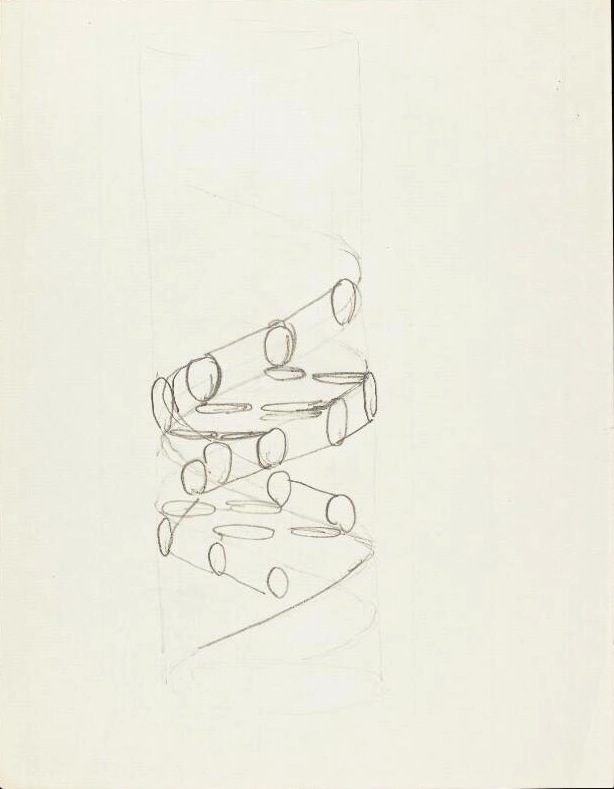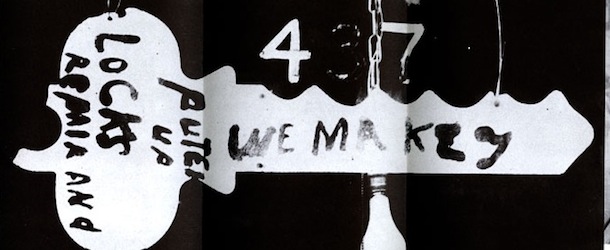An iconographic and text archive related to communication, technology and art.
In this link roundup: microbiome and immunity, the failure of language, typography, calligraphers, vernacular signs, uncreative writing, a documentary about The Pirate Bay, drones, the art of the essay, the fading away of the sensible, when Sartre met Andreas Baader, the art of the Japanese stencil-cutter, the value of opinions, horse meat and modernity, bacteria on smart phones, video game design, Homer, and finally an archive of documents related to modern genetics.
As usual, when present images are linked to the content they illustrate. All those links were first collected on @aphelis (Twitter). Previous link roundups can be found here.
• • •
-
Parallax: “Eating Autonomy” by Eszter Timár, Volume 19, Issue 1, 2013, pp. 38-49 (a subscription may be required for full access).
The above summary of the microbiome features the key terms of this paper: the connection between the digestive tract, digestion, the brain and the process by which we maintain our biological autonomy and protection from our environment via our immune system. It also suggests a crucial difficulty in conceiving of this biological autonomy in terms of a protected inside and a nurturing, but also often threatening, outside. Internality and exteriority become so entangled by the fact that we are just as much the environment of our microbiomes as they are, in turn, our internal environment. (p. 38)
-
University of Notre Dame Press: On What Cannot Be Said. Vol. 1 (see also Vol. 2) by William Franke, 2007. Excerpt from the “Preface” (PDF):
This book brings into comparison some of the most enduringly significant efforts within Western culture to probe the limits of language—and perhaps to exceed them. All tend to delineate regions of inviolable silence. A certain core of readings is made up of classic expressions of negative theology—the denial of all descriptions and attributes as predicated of God. For negative theologies, it is possible to say only what God is not. These attempts to devise and, at the same time, disqualify ways of talking about God as an ultimate reality, or rather ultra-reality, beyond the reach of language, are juxtaposed to (and interpenetrate with) philosophical meditations that exhibit infirmities endemic to language in its endeavor to comprehend and express all that is together with the grounds of all that is. Such philosophical reflections expose necessary failures of Logos that leave it gaping open toward what it cannot say.
-
Musée de l’imprimerie de Lyon: “Corpus typographique français”
Le Corpus typographique français recense les polices de caractères dessinées en France entre 1850 et aujourd’hui. Il se veut une illustration de la création française dans ce domaine. Il n’a pas pour but d’être exhaustif mais représentatif : s’y côtoient des grands classiques et des créations plus obscures, des caractères de labeur « sérieux » et de la « titraille » fantaisiste, des créations de haute volée mais, aussi, des caractères médiocres, voir mauvais, car l’histoire de la typographie en comporte également.
Explore the collection here. Each one of the 1532 items from this archive is very well documented (in French).
-
Container List: “Love Is A Sign” by Beth Kleber, February 20, 2013. From 1957, a photographic study of vernacular signs:
Subtitled “A study of folk art on the Lower East Side,” “Signs” explored just one element of the studio’s stylistic diversity, but it signalled the kind of reverence the artists held for the art of the vernacular (…)
-
Design Bridge Blog: “Interview with calligrapher and artist Frederick Marns” by Lisa L., February 26, 2013.
“Any really fine designer needs to have some connection with drawing and using their hands. It’s very useful for a designer to be able to draw what’s in their mind. You can’t expect every one of them to be able to do that. Lots of people have great ideas but being able to draw makes the complete designer.”
-
Vimeo: Calligrapher Seb Lester demonstrates the art of calligraphy by tracing samples of BlackLetter Gothic script. The pen he’s using is a Pilot Parallel pen. Seb Lester was featured here in link roundup 13.02. Check his website at seblester.co.uk
BlackLetter was used throughout Europe from about 1150 until the end of the 17th century. One of my current preoccupations is developing a set of modern BlackLetter capitals that are highly legible, in BlackLetter terms, and yet retain the richness and beauty inherent in this ancient category of letterform. From time to time I will film clips like this to record my progress.
-
The Awl: “Proudly Fraudulent: An Interview With MoMA’s First Poet Laureate, Kenneth Goldsmith” by Mark Allen, February 6, 2013. For those interested in Oulipo or in exploring the limits of creative writing (or “uncreative” writing), this is a must read, and all the way until the end. Kenneth Goldsmith is an American poet and the founder of the famous UbuWeb website.
That evening, with the President sitting five feet away from me, I read appropriated texts. Nobody flinched. I put together a short set featuring The Brooklyn Bridge, and presented three takes on it, including Whitman’s “Crossing Brooklyn Ferry,” Hart Crane’s “To Brooklyn Bridge,” finally finishing with an excerpt from my book Traffic, which is 24-hours worth of transcribed traffic reports from a local New York news station. The crowd, comprised of arts administrators, Democratic party donors, and various Senators and mayors, respectfully sat through the “real” poetry—the Whitman and Crane—but when the uncreative texts appeared, the audience was noticeably more attentive, seemingly stunned that the quotidian language and familiar metaphors from their world—congestion, infrastructure, gridlock—could be framed somehow as poetry. It was a strange meeting of the avant-garde with the everyday, resulting in a realist poetry—or should I say hyperrealist poetry—that was instantly understood by all in the room; let’s call it radical populism. It was really fucking bizarre, to say the least.
-
The Pirate Bay – Away From Keyboard by Simon Klose, Sweden, 2013, 82 mins (full film on YouTube):
It’s the day before the trial starts. Fredrik packs a computer into a rusty old Volvo. Along with his Pirate Bay co-founders, he faces $13 million in damage claims to Hollywood in a copyright infringement case. Fredrik is on his way to install a new computer in the secret server hall. This is where the world’s largest file sharing site is hidden.
-
DIY Drones was founded by Chris Anderson. Former Editor in Chief of Wired Magazine and author of The Long Tail, he’s now CEO of 3D Robotics. DIY Drones is an online community center arround amateur Unmanned Aerial Vehicles (UAVs):
An Unmanned Aerial Vehicle (UAV, colloquially known as a “drone”) is basically an aerial robot. As we define it, it is capable of both remotely controlled flight (like a regular RC aircraft) and fully-autonomous flight, controlled by sensors, GPS, and onboard computers performing the functions of an autopilot. Our UAVs include airplanes, helicopters, quadcopters and blimps. Most of them are under five pounds, and some of them (especially the blimps) can be used indoors.
We are focused on non-commercial (“recreational”) projects by amateurs, although pros are always welcome too. Reasons to make your own UAV range from a fun technical challenge, student contests, aerial photography and mapping (what we call “GeoCrawling”), and scientific sensing. We are primarily interested in civilian, not military, UAV uses here.
-
The Verge: “Romancing the drone: how America’s flying robots are invading pop culture” by Joshua Kopstein, February 18, 2013.
More importantly, we’re having trouble figuring out exactly what drones are in the first place: The State’s Adam Rothstein submits that what we call a “drone” — which lumps military killing machines together with toy helicopters — isn’t “real” at all. Rather, it’s a fictitious characterization comprised of “a collection of thoughts, feelings, isolated facts, and nebulous paranoias,” reacting to the rapid accumulation of augmentative technologies like cellphone cameras, GPS, and ubiquitous wireless communication networks. Therefore, he argues, whenever we talk or write about unmanned flying machines used to see or attack from a distance, we are by necessity crossing into the realm of fiction.
-
The New York Times: “The Essay, an Exercise in Doubt” by Phillip Lopate, February 16, 2013.
According to Theodor Adorno, the iron law of the essay is heresy. What is heresy if not the expression of contrarian doubt about communal pieties or orthodox positions? This is sometimes called “critical thinking,” an ostensible goal of education in a democracy. But since such thinking often rocks the boat, we may find it less than supported in school settings. Typically, the exercise of doubt is something an individual has to cultivate on his or her own, in private, before summoning the courage to air it, say, in an essay.
-
The New Republic: “The New Essayists, or the Decline of a Form? The essay as reality television” by Adam Kirsch, February 18, 2013.
The essay, traditionally, was defined by its freedom and its empiricism—qualities that it inherited from its modern inventor, Montaigne. “What do I know?” Montaigne asked, and the essay is the form that allows both the “I” and the thing it knows equal prominence. For this reason, the essay could address any subject, exalted or trivial, as long as it displayed the mind of the writer engaged with the world. The subjects in The Oxford Book of Essays, edited by the late John Gross, range from truth and dreams to wasps and the Hoover Dam. Not coincidentally, some of the greatest essays, from Addison on Paradise Lost to Mill on Coleridge, are engaged with texts, which is to say, with other minds. For the essay is one of the purest ways for a writer’s mind to record its own motions, which are the basis of prose style.
-
Frieze: “Energy & Rue” by Brian Dillon, Issue 151, November-December 2012.
The essay is the most ambiguous literary or artistic form going, or maybe gone. It’s at once an antique, redolent of libraries crammed with dusty tracts and improving pensées, and a way of writing oneself into the unknown, a style or mode that’s all swagger and risk and theatrical conjecture. For sure, there are academic essays, but they become essays at the moment they aspire to be other than academic, when they sideline rigour for the pleasures of seduction and surprise.
The Senses and Society: “Embers of the Sublime: Sacrifice and the Sensation of Existence” by Gerald Moore, Volume 8, Number 1, March 2013 , pp. 37-49 (subscription may be required for full access).
[Jean-Luc] Nancy seems to imply the prospect of increasingly coming into contact with a sublime “évanouissement du sensible,“ a fading away of the sensible encountered at the limits of experience. In saying this, he comes into contact with what Bernard Stiegler has described as a “catastrophe du sensible“ – a vitiation of affect that is anything but sublime, and which, following the mass-murderer Richard Durn, he identifies with “the loss of the feeling of existing [la perte du sentiment d’exister].“
Spiegel Online: “The Philosopher and the Terrorist: When Sartre Met RAF Leader Andreas Baader” by Felix Bohr and Klaus Wiegrefe, February 6, 2013.
Jean-Paul Sartre’s meeting with RAF leader Andreas Baader was long considered to be one of the philosopher’s great missteps. A transcript of the meeting, which has only now been released, shows the Nobel laureate actually wanted to persuade him to stop murdering people.
SoShare is a new sharing service (at the time of writing still in beta). It allows a sender ―who must sign in― to share a file online of up to 1TB in size (that’s one terabyte) for a duration of one month. The receiver doesn’t have to sign in. Receivers may be private (a link is shared by email) or the link may be public (everyone can access it). BitTorrent is the owner and SoShare seems to work on BitTorrent’s protocols.
Codex 99 no. 139: “The Art of the Japanese Stencil-Cutter”, February 20, 2013.
Japanese textile weaving and dying goes back to the eight century AD, however finely brocaded silk, e.g., would be within the reach of only nobility or royalty, so by the 17th century artisans around Suzuka developed katazome (型染め) – a simpler, less costly fabric-dying technique to mimic the appearance of finely-woven textiles.
Codex 99 is a weblog “about the history of the visual arts and graphic design”. It’s updated once or twice a month and each of its article is very well documented. Check its archive and monitor future updates on its Twitter or Facebook account.
The Guardian: “If you want my opinion, what we need are experts, not windbags” by Robin Ince, February 24, 2013. Excellent piece on what could be called “the tyranny of uninformed opinions”. One more link related to this topic after this excerpt:
Neil Postman, author of the magnificently titled Amusing Ourselves to Death, wrote that we should cut down our opinions by one-third. As this was in the early days of 24-hour news and before the internet, I now imagine three-quarters would be nearer the mark. Opinions have overtaken information and facts as a necessity. Everyone is not only entitled to their opinion, it is considered the height of rudeness to suggest that their opinion is balderdash; the height of rudeness, but great TV too.
With so much airtime to fill, a few orange chairs and some venomous dogmatists can fill an hour. Then you can follow up the show you’ve just shown with another show where people give their opinions on the opinions they have just witnessed and then another show about how hearing those opinions on opinions has affected people who fear opinions. Everyone must be encouraged to form as many opinions as possible, phone them in, tweet them, place them under features on the internet, join forums. If you do not feel outraged or wronged, are you alive?
A similar argument was made a while ago by Patrick Stokes at The Conversations: “No, you’re not entitled to your opinion” (October 5, 2012):
The problem with “I’m entitled to my opinion” is that, all too often, it’s used to shelter beliefs that should have been abandoned. It becomes shorthand for “I can say or think whatever I like” – and by extension, continuing to argue is somehow disrespectful. And this attitude feeds, I suggest, into the false equivalence between experts and non-experts that is an increasingly pernicious feature of our public discourse.
Prolapsarian: “On the composition of lasagna: A caprice on horses, abstraction, and the division of labour” by JBR, February 23, 2013.
I want to know if that disgust at horsemeat is separable from the disgust at the conditions under which today we can be expected, and will be expected, to continue living.
Exploring The Invisible: “The Smart Phone As A Vector” by Simon Park, February 11, 2013.
Bacteria can utilize many different things as vectors in order to promote their transmission. Insects, water, food, coughs and sneezes, sexual contact, and rain are just a few examples. The mobile phone appears to be no exception this rule. As part of BMS1035 Practical and Biomedical Bacteriology, an undergraduate module that I run, I get the students to to imprint their mobile phones onto bacteriological growth media so that we might determine what they might carry.
The New Republic: “Why an Experimental Video Game Is More Anticipated Than Sony’s Playstation 4” by Liel Leibovitz (@liel), March 1, 2013.
And yet, technological capacity alone does not explain the current wave of experimental games. Other art forms have similarly benefited from cheaper content development tools and more accessible distribution platforms, yet few filmmakers and photographers have embraced these freedoms as giddily as game designers have. The reason is cultural: The hacker ethos reigns among gamers and designers alike, which pressures the industry to innovate—and to do so cheaply and quickly.
BioEssays: “Linguistic evidence supports date for Homeric epics” by Eric Lewin Altschuler, Andreea S. Calude, Andrew Meade and Mark Pagel, February 18, 2013 (subscription may be required for full access).
The Homeric epics are among the greatest masterpieces of literature, but when they were produced is not known with certainty. Here we apply evolutionary-linguistic phylogenetic statistical methods to differences in Homeric, Modern Greek and ancient Hittite vocabulary items to estimate a date of approximately 710–760 BCE for these great works.
Wellcome Library: “Codebreakers: Makers of Modern Genetics” is an “online research resource for the history of genetics, including digitised books and archives from the Wellcome Library and partner institutions.” Here’s the official presentation retrieved for the project’s blog:
Back in 2010 we began a long term project to digitise our collections. Our aim was (and is) to put 30 million pages online by 2020. Today we’re taking a major step towards that goal. Codebreakers: the makers of modern genetics contains over a million pages of books and archives relating to the history of genetics. Another half million pages will be added over the next few months.
Below is a sketch by Francis Crick from the Crick archive (reference PPCRI/H/1/16).

- By Philippe Theophanidis
- on
- ― Published in Link-roundup











